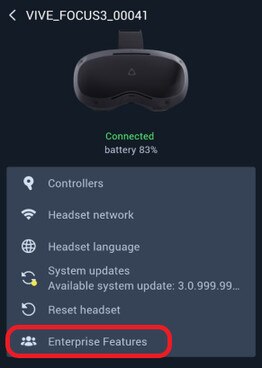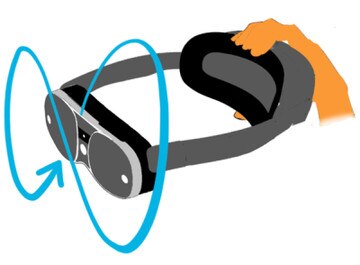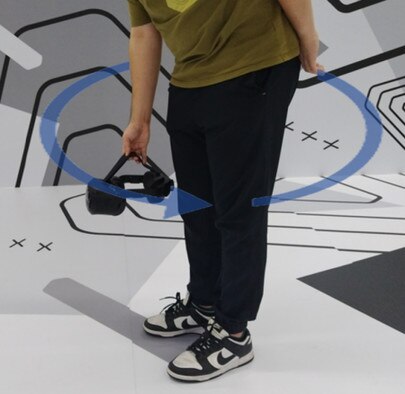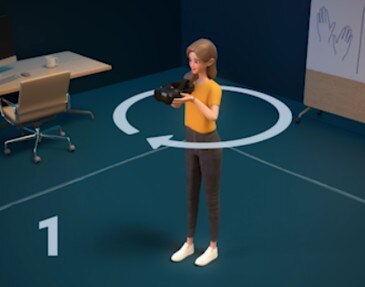-
简介
-
追踪模式
-
ArUco 标记和基于标记的追踪功能
-
基于标记的追踪功能
-
-
基于标记的位置共享设置
-
LBE 模式/LBE 混合模式设置
-
LBE 地图配置
-
基于标记的防漂移设置
-
基于标记的高级重新定位设置
-
基于标记的场景对齐设置
-
VR 模拟器模式设置
-
其他服务
-
更多功能
使用 VIVE Manager 创建地图
您可以将 VIVE Manager 与主头戴式设备配合使用来创建游玩区的虚拟地图。
注:
-
在尝试创建虚拟地图之前,请确保头戴式设备已与 VIVE Manager 配对。有关详细信息,请参见将主头戴式设备与 VIVE Manager 配对。
-
在创建地图之前,请务必清除头戴式设备上的追踪地图。您可以使用 VIVE Business+ 来清除地图。有关详细信息,请参见 VIVE Business+ 用户指南中的导出地图和地图边界数据。
-
在 VIVE Manager 中,选择您的头戴式设备,然后点击企业版功能。

-
输入激活码并点击激活。
注:
对于 2.0.12 之后的版本,当头戴式设备登记并配置为 LBE 模式或 LBE 混合模式时,企业功能会自动启用,无需激活码。
- 验证完成后,点击 LBE 地图配置。
- 点击地图创建。
-
校准头戴式设备摄像头。
VIVE Manager 将提示您校准头戴式设备摄像头。
-
检查头戴式设备摄像头的校准状态。要进行检查,请牢牢握住头戴式设备的电池,并在扫描周围环境时绘制一个“8”字形。

开始扫描时,会出现一个进度条。继续扫描直到进度条达到 100%。
如果头戴式设备摄像头已校准并正常追踪,您可以开始创建地图。如果没有,您将需要扫描环境以收集数据并校准摄像头。 - 校准摄像头。要进行校准,请按照检查校准状态相同的方式移动头戴式设备。VIVE Manager 会提示您头戴式设备是否移动过快或过慢。
- 如有需要,请重复该过程。 当您收集到足够的数据时,VIVE Manager 会处理这些数据并再次检查校准状态。如果校准成功,您可以开始创建地图。如果没有,您将需要重新开始该过程。
注:如果摄像头校准多次失败,您的游玩区可能没有足够的视觉数据来支持由内向外追踪。请确保您的环境光线充足,墙壁和地板上有大量复杂、对比强烈的图案。
-
检查头戴式设备摄像头的校准状态。要进行检查,请牢牢握住头戴式设备的电池,并在扫描周围环境时绘制一个“8”字形。
- 移动到游玩区起始区域的中心位置。
- 可选:如果您为基于标记的防漂移或基于标记的高级重新定位配置了 ArUco 标记设置,请点击选择文件,然后从您的移动设备中选择 JSON 文件。
-
在 VIVE Manager 中的地图创建屏幕上,点击开始。
将会出现正在扫描…的信息。
-
将头戴式设备保持在肩膀高度并朝向前方。头戴式设备将从待机状态唤醒并开始扫描。
注:
如果您正在创建用于 VIVE 自定位追踪器的地图,您需要在膝盖高度扫描游玩区的每个区域以支持低角度追踪。

-
以单一、连续的动作旋转 360°,持续 5 秒。在转动时保持头戴式设备静止不动。

-
再次旋转 360°,但这次在转动时上下倾斜头戴式设备。此操作持续 9 秒。

-
以正常速度沿着区域的边界行走以追踪区域边界。在行走时保持头戴式设备静止不动。

- 移动到要扫描的下一区域,点击下一步,并重复扫描过程。
-
当您完成每个区域的扫描后,点击完成扫描。
注: 如果地图使用率超过 100%,旧的地图数据将被丢弃以释放空间。
- 将头戴式设备放置在游玩区的中心位置并朝向前方,然后点击设置。
- 指定您的地图区域(以米为单位),然后点击保存。
地图将保存到头戴式设备,系统会提示您重新启动设备。重新启动头戴式设备后,您可以导出地图。有关详细信息,请参见 VIVE Business+ 用户指南中的导出地图和地图边界数据。
注:
如果扫描中断(例如,头戴式设备进入待机模式或关机),您需要将头戴式设备重新连接到电脑,并在再次扫描游玩区之前清除追踪地图。
此内容对您有帮助吗?
是
否
提交
谢谢!您的反馈可以帮助其他人了解最有用的信息。